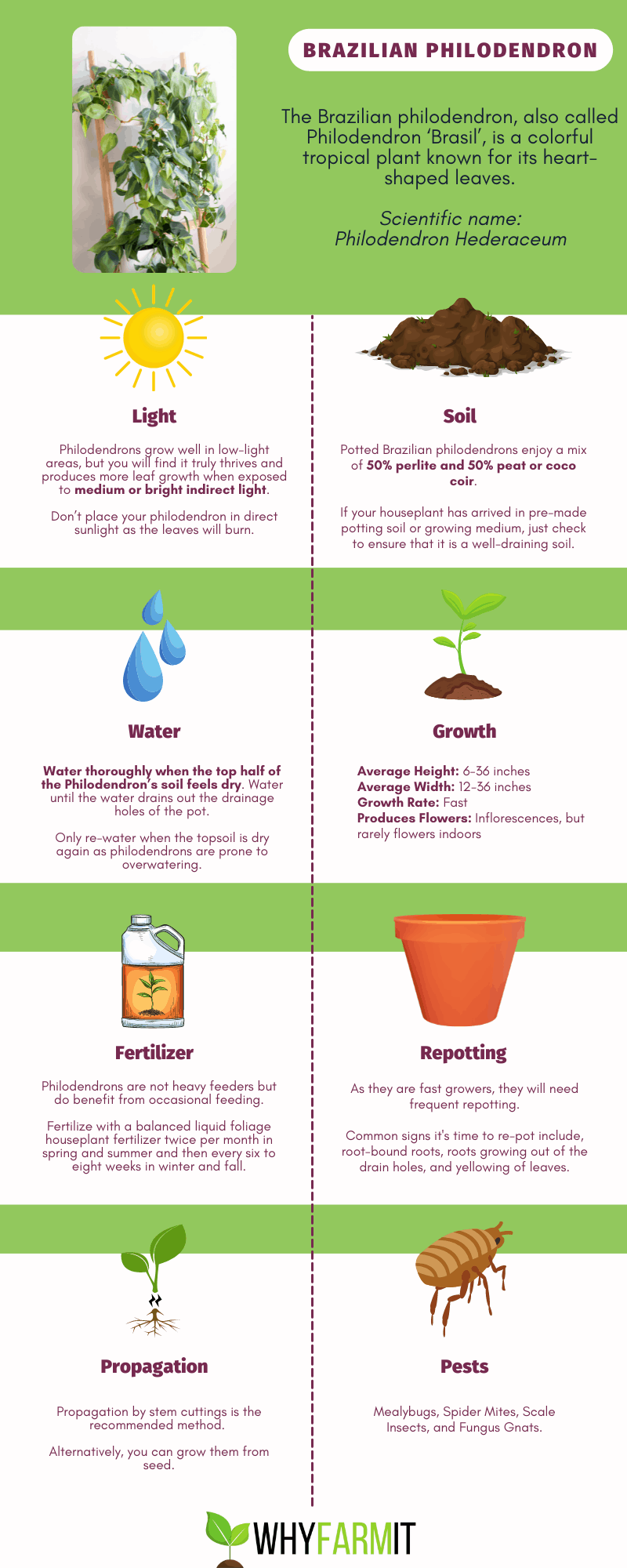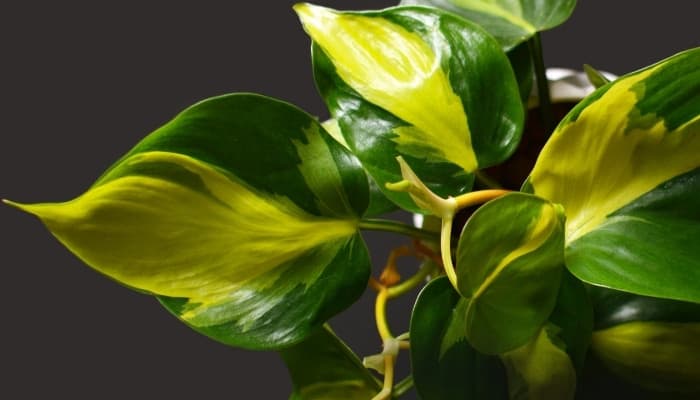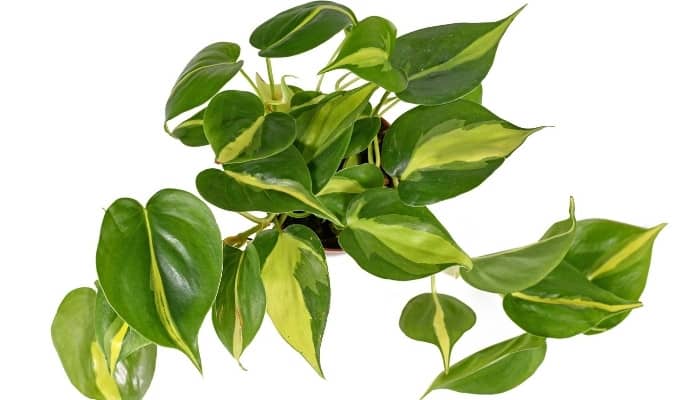The Philodendron ‘Brasil’, known informally as the Brazilian philodendron, is a vibrantly hued house plant that has already won the hearts of countless households — thousands, perhaps even millions.
Not only is this one of the easiest and most rewarding tropical plants to grow indoors, but its heart-shaped leaves are attractive and charming.
Most Brazilian philodendron lovers know that these plants tolerate all kinds of conditions in which other plants just wouldn’t fare well.
That said, plant lovers don’t just want their houseplants to get by, but rather they want them to thrive.
That’s why we’ve pieced together this in-depth guide on growing and caring for Brazilian philodendrons.
How do you care for Brazilian philodendron? Brazilian philodendrons require bright, indirect light and a light soil that drains well. This plant thrives in 60-90% humidity and temperatures between 70-80℉. Water the Brasil once a week, allowing the topsoil to dry out between watering. Fertilize twice per month in spring and summer.
Caring for Brazilian Philodendron: Basic Guidelines
The above table is just a sneak peek at what to expect when loving and nurturing a Brazilian philodendron.
Want to know a little more about getting your houseplant in the best condition of its life? Read on! Everything you need to know can be found below.
Complete Care Guide for Brazilian Philodendron
Getting to know your Brazilian philodendron is the best way to ensure you’re taking care of all of its needs.
Below you will find more insight into what makes your Brazilian philodendron happy and healthy (and what makes it not happy too).
Brazilian Philodendron at a Glance
The Brazilian philodendron has been a crowd-pleaser for years with its fast-growing habit and beautiful yellow-green variegated heart-shaped leaves.
This houseplant is native to South America and is called “Brazilian” philodendron because the green and yellow stripes on the leaves resemble the Brazilian flag.
Because these plants tolerate a considerable amount of neglect, they make for good gifts or beginner plants.
Here’s the Brazilian philodendron at a glance:
- Plant Type: Tropical
- Scientific Name: Philodendron hederaceum ‘Brasil’
- Average Height: 6-36 inches (15-91 cm)
- Average Width: 12-36 inches (30-91 cm)
- Growth Rate: Fast
- Produces Flowers: Produces inflorescences, but rarely flowers indoors
- Common Pests: Mealybugs, scale, and spider mites
- Difficulty of Care: Easy, low maintenance
What To Do When You First Get Your Philodendron Brasil
When getting a Philodendron ‘Brasil’, the first thing you need to do is to ensure that it’s planted in a decent pot.
If you happen to have received the plant as a gift or just bought it from the nursery, it may be in a temporary container or grow bag.
You must plant your Brazilian philodendron in a pot that has sufficient drainage holes as the plant does not like having “wet feet.”
Find a suitable spot in your home near a window that offers medium to bright light. Never place your philodendron in direct sunlight, as the leaves will easily burn.
When choosing the ideal placement for your houseplant, make sure that it’s away from drafts from the heating vent and air conditioner.
While the Philodendron ‘Brasil’ thrives in humid environments, it will do just fine in your home as long as it’s protected from drafts.
Ideal Soil for Brazilian Philodendron
Potted Brazilian philodendrons enjoy a mix of 50% perlite and 50% peat or coco coir.
If your houseplant has arrived in pre-made potting soil or growing medium, just check to ensure that it is a well-draining soil.
Brazilian Philodendron Water Requirements
Before watering your houseplant, poke your finger into the soil to check how dry it is.
When the top half of the Philodendron’s soil feels dry when you touch it (at least half the soil), you can go ahead with watering the plant thoroughly until the water drains out the drainage holes.
Only re-water when the topsoil is dry again. Overwatering can lead to root rot (something philodendrons are prone to). Discard any accumulated water in the saucer.
Brazilian Philodendron Lighting Needs
Philodendrons grow well in low-light areas, but you will find it truly thrives and produces more leaf growth when exposed to medium or bright indirect light.
The variegation on the leaves is more noticeable when exposed to high amounts of light. Don’t place your philodendron in direct sunlight as the leaves will burn.
Ideal Temperature Range for Brazilian Philodendron
Potted philodendrons do best in temperatures between 70 and 80℉ (21 to 26℃). At night, it can withstand a temperature drop to no less than 55℉ (12℃).
Ideal Humidity Level for Brazilian Philodendron
While the philodendron will grow fine in your home’s basic humidity, it does best in high humidity, even as high as 90%.
In fact, it will grow larger leaves if provided with an occasional boost in humidity.
Therefore, aim to mist the leaves of your houseplant twice a week to keep it happy and thriving.
Best Location for Brazilian Philodendron
Just because the Brazilian philodendron does well in low-light conditions doesn’t mean it has to suffer in such conditions!
The best locations for your plant are near east- and west-facing windows but out of direct sunlight and drafts.
Brazilian Philodendron Growth Habits
In its native habitat, philodendrons can quickly grow up to 15 feet long. They can still reach similarly astounding lengths in cultivation, but they do grow considerably slower.
They typically grow 3.9 inches (10cm) per week in the growing season.
If you want to boost its growth, provide it with high indirect light and mist it often for added humidity.
Fertilization Type & Schedule for Brazilian Philodendron
Philodendrons are not heavy feeders but do benefit from occasional feeding. The best fertilizer for it is a balanced liquid foliage houseplant fertilizer with included macronutrients.
Fertilize twice per month in spring and summer and then every six to eight weeks in winter and fall.
Signs of Nutrient Deficiency
If your philodendron has yellowing leaves or new leaves that are small or misshapen, it’s a sign that your plant has a nutrient deficiency.
Correct this problem by using a complete, balanced fertilizer made specifically for tropical houseplants or, even better, a fertilizer made specifically for philodendrons.
Pruning Brazilian Philodendron
Prune your philodendron any time of the year, but it’s recommended to do so at least once per year. Follow these steps to prune your philodendron:
- Trim off the oldest stems first – these are the longest stems and prone to turning yellow first.
- Using sharp pruning scissors, cut the stem where the join means the main crown of the plant.
- If you notice that the stems are descending beneath the soil, cut them off at the soil line.
- Thoroughly water your philodendron immediately after pruning.
Does Brazilian Philodendron Produce Flowers?
While the philodendron does flower rarely indoors, it does not produce real flowers. Instead, it produces 12-inch long inflorescences.
These blooms only open for 48 hours, and each plant only gets two or three blooms.
Flowering typically happens from May to July, and some philodendrons can take as long as 15 years to start flowering.
Is Brazilian Philodendron Toxic?
Philodendrons are toxic to humans and pets. Ingesting the leaves will result in the lips and tongue swelling and irritation to the stomach resulting in vomiting.
Philodendron Brasil Propagation
The two primary forms of propagation of philodendrons are stem cuttings in water and seed growing.
Water Propagation of Philodendron Brasil
The most common form is water propagation with stem cuttings.
1. Cut a Section of Stem an Inch Below the Leaf Node
It’s important to use sharp, clean shears (or scissors) when cutting stems or tips.
Choose a section where you can make a clean cut 1 to 2 inches below the area where the leaf attaches to the vine.
2. Place the Stem in Water Without Allowing Leaves to Sit in the Water
It’s best to use a clear jar of water – half fill the jar with water and submerge only the stem in the water.
If any leaves rest in the water, they will rot, so either remove them or use less water in the jar.
3. Place the Philodendron Cutting in a Spot With Bright Indirect Light
Position your Brazilian philodendron cutting in a bright spot without exposing it to direct sunlight.
In just a few days, you should see roots starting to grow on the end of the stem. Change the water every two days.
4. Transfer the Cutting to Soil When the Roots Are 1-Inch Long
In about a week, the roots should be sufficiently developed, which means you can transfer the cutting to the soil.
A 6-inch (15 cm) diameter container is needed for this (do not use a larger pot as this can stunt growth).
5. Keep the Cutting Well Hydrated for the Next Three Weeks
During the first few weeks when the rooting process is underway, the philodendron cutting must be kept well hydrated.
Water and drain the cutting regularly to ensure the soil is slightly moist at all times.
Propagating Philodendrons with Seed Sowing
You can harvest seeds from your existing Brazilian philodendron plants or buy the seeds online or at your local garden center.
Follow these steps to propagate your philodendron with seeds:
1. Prepare Well-Draining Potting Mix in a Container
General potting mix will work just fine. Fill your chosen container with it, and then soak it with water. Allow the water to drain out.
There’s no need to soak the seeds before planting.
2. Plant Each Seed ½ Inch (1.5 cm) Deep and 2 Inches (2.5 cm) Apart
You should be able to plant two or three seeds in one container.
3. Cover the Soil With Plastic
Philodendrons are native to tropical, humid environments, so it’s best to cover the soil with plastic to trap moisture and heat.
Check the philodendron’s soil regularly to ensure it is moist and at a temperature of around 70℉ (20℃). You should see the first shoots in approximately four weeks.
Repotting Brazilian Philodendron
Philodendrons are vigorous growers and as such will require regular repotting.
When To Repot Brazilian Philodendron
When the roots start to protrude from the container’s drainage holes or if you notice that your Brazilian philodendron is showing signs of being rootbound, it’s time to repot.
In some cases, the roots start to push the plant up and out of the container or the leaves turn yellow from lack of nutrients. In both instances repotting is required.
The best time to repot is late spring and early summer.
Signs You Need to Repot Your Philodendron
- Roots growing out of the drainage holes.
- Roots of the plant are rootbound.
- Roots starting to push the plant up and out of the container.
- Yellowing leaves.
How To Repot Brazilian Philodendron
As a Brazilian Philodendron owner, you will need to become familiar with the repotting process. Follow these steps:
1. Select a Container One Size Bigger
As your houseplant grows, you can gradually increase the size of the container. Choose a container for your Philodendron ‘Brasil’ that is one size bigger than the pot you are currently using.
2. Prepare the Soil Mix
Fill the pot with a combination of 50% peat or coco coir and 50% perlite.
3. Gently Remove the Philodendron From Its Old Pot
Ease your plant out of its existing pot to avoid damage to the roots and stem.
If the roots are bound, gently ease them apart so that they will be more comfortable in their new environment.
4. Place the Philodendron in the New Container and Water
Ensure that you cover the roots with sufficient soil and water the soil thoroughly. Drench the soil right through, and then only re-water when the topsoil is drying out.
Brazilian Philodendron Common Problems & Solutions That Work
Brazilian Philodendron Common Pests
The Brazilian philodendron is not the #1 target of pests, but there are occasions where pest infestations happen.
Knowing what you should expect and how you can overcome the problem can help you keep your plant healthy and happy.
Below is a brief look at some of the common pests that tend to attack philodendrons.
Fungus Gnats
Fungus gnats are small, dark, fly-like insects that like moist and humid environments.
The most common cause of infestation is placing your plant in a damp area or overwatering.
Fungus gnats won’t bite you or your plant, but the larvae, if in large numbers, can result in damage to the roots of the plant and stunt its growth.
Signs of Trouble
You may see gnats flying around your plants. In some instances, if there is a larvae infestation, your plant may wilt, lose growth vigor, and the leaves may turn yellow.
Solution
Several methods can be used for getting rid of fungus gnats. One way is to use sticky paper to trap them.
Another method includes mixing ¼ cup of apple cider vinegar with three drops of dish-washing liquid in a container.
Cover the container with apple cider vinegar with plastic wrap, and poke a few holes in it. Fungus gnats are attracted to vinegar and will get trapped beneath the plastic.
Oil-based insect sprays also work well.
Prevention
To prevent infestation, don’t overwater your houseplant and clear away debris underneath and around the plant.
You can also place a layer of horticultural sand on top of the plant’s soil – gnats don’t like laying their eggs in sand.
Scale & Aphids
Scale and aphids are tiny insects that affix to the bottom of the philodendron’s leaves and have a detrimental effect on the plant.
The insects sap the plant’s juices out through the leaves and make little droplets of sticky honeydew at the same time.
Signs of Trouble
Check your plant for round bumps on the leaves and stem.
Scale and aphids usually create a sticky honeydew on the underside of leaves and the stem, which can lead to black sooty mold growth.
In some cases, the leaves can turn yellow and wilt and the plant can experience overall stunted growth.
Solution
Remove the infected leaves, branches, and twigs. If you have a light infestation, you can rinse the bugs off quite easily.
For more serious infestations, spray the plant with a neem-based spray (I get excellent results with this neem oil).
Prevention
Preventative spraying every few weeks with an oil-based horticultural spray is the best way to ensure that scale and aphids don’t find your philodendron an attractive place to feed and live.
Spider Mites
These are tiny insects that look just like spiders. They can be red, green, yellow, brown, or white.
These mites pierce the leaves of the plant and feed on the chlorophyll and vital juices.
Signs of Trouble
Spider mites appear as tiny silvery dots on the leaves of plants. You can also see tell-tale signs of them by the webs they make on the plant’s leaves and stems.
If your Brazilian philodendron has yellow or brown spots on the leaves, is wilting, or has drying leaves, it could be infested with spider mites.
Solution
The first step is to wash your plant down to remove the spider mites.
You can also spray the plant with neem-based spray or make a DIY solution of 2 cups of water, 1 teaspoon of cooking oil, and 1 teaspoon of dish-washing liquid.
Put this mixture into a spray bottle, and thoroughly spray the plant.
Prevention
To prevent infestations, periodically soak cotton balls in rubbing alcohol and wipe your plant down. Let the alcohol sit on the plant for a few hours, and then rinse the plant down.
Mealybugs
Mealybugs are small, white, soft-bodied insects that have a similar modus operandi to scale and aphids in that they sap the juice from the leaves of the plant, which can cause the plant to weaken and die.
They also produce a type of honeydew that attracts ants and can cause mold growth too. Plants infested with mealybugs often die.
Signs of Trouble
Philodendrons with a mealybug infestation will start to wilt and show drooping, yellowing leaves.
The leaves may start to drop from the plant, and you might even notice dieback.
Solution
Immediately remove the present mealybugs by dipping cotton balls in alcohol and wiping them off.
You can also mix ½ cup of rubbing alcohol, ¼ cup of water, and three drops of dish-washing liquid.
Put this alcohol-oil-detergent solution into a spray bottle, and thoroughly spray the plant down. Repeat every 10 days.
Prevention
The best way to prevent mealybug infestations on your philodendron is to do preventative spraying every two weeks with an oil-based horticultural spray.
Brazilian Philodendron Common Diseases
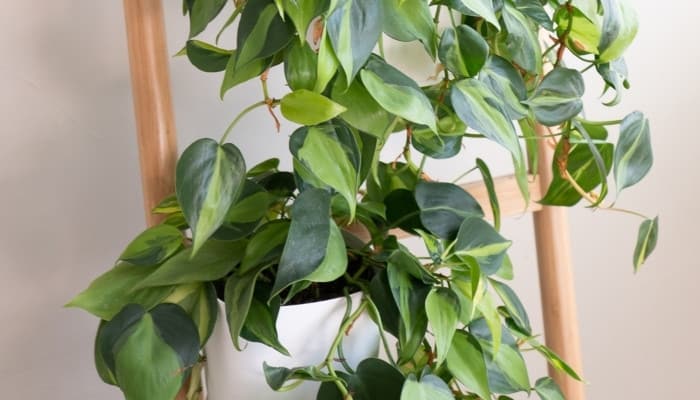
The Brazillian philodendron’s tough resilience to pests and diseases means it doesn’t often struggle with infestations.
Additionally, because it has an exceptionally fast growth rate, it recuperates relatively quickly from any growth lost to disease.
This plant’s main form of disease is different types of leaf spot.
Bacterial Leaf Spot
Brown spots and black-edged lesions sized anywhere from 0.19 to 0.30 inch (5 mm to 1 cm) is a sign of bacterial leaf spot.
Signs of Trouble
Clear spots on the leaf edges turn reddish brown with cream or yellow outlines; these spots are unevenly shaped. This is caused by Xanthomonas campestris pv. Dieffenbachiae.
Solution
Prune infected leaves and dispose of them safely. Use a copper-based spray on the plant.
Prevention
Too much moisture on the leaves is the main cause of this disease. Water the plant at the base of the stems keeping the leaves dry.
Also ensure that your plant is free of disease when purchased. Do preventative copper-based spraying every month.
Bacterial Blight Philodendron Selloum
If your philodendron has dark brown dead spots with yellow halos in the leaves, it’s a sign that the plant has blight.
Signs of Trouble
Leaves start exhibiting little dark-green spots that swiftly increase in size until they reach the leaf stems (petioles).
Finally, the infected leaves droop and disintegrate into a wet rot that smells unpleasant. This is caused by Erwinia carotovora pv. Carotovora E. chrysanthemi
Solution
Remove any infected leaves on the philodendron as soon as you notice them. Use a general fungicide spray on your plant.
Prevention
When watering the plant, aim the water close to the base of the stems ensuring that water splash on the leaves is kept to a bare minimum.
Magnesium Deficiency
Brown tinted leaves with yellowing is a sign of magnesium deficiency.
It’s easy to miss, and many people think the plant has an infestation or has fungus when they first see magnesium deficiency.
Signs of Trouble
The leaves start yellowing with the veins extruding. This will cause all the leaves and the plant to eventually die.
Solution
Water your plant with a magnesium-enriched water solution. Apply 1 teaspoon of magnesium sulfate (Epsom salts) per 4.5 liters of water.
Prevention
To prevent magnesium deficiency, use a magnesium leaf spray such as Epsom salt.
In addition, using a rich, organic compost (found at any garden center or make your own – learn about composting here) conserves moisture and prevents the leaching of nutrients.
Other Common Problems
Although philodendron Brazil is straightforward to grow, it can suffer from some fairly common problems that are easily resolved.
Tip Curl
Tip curl can be caused from various reasons, such as overwatering or placing the plant in an environment that’s dry or drafty.
Signs of Trouble
The leaf tips curl downwards and become droopy; eventually they turn brown.
If ignored, this can lead to the plant’s roots dying. Usually this is a sign the plant has been over fertilized.
Solution
Reduce the amount of fertilizer in the soil by watering thoroughly to encourage the excess fertilizer to leach out.
If you have used a slow-release fertilizer it’s best to repot the plant using fresh soil. Move the plant to an area of the home that doesn’t get heating and air conditioner drafts.
Prevention
Use half a teaspoon of granular fertilizer diluted in water every two weeks in the summer months.
Feeding is only required every six to eight weeks in the winter.
Follow the fertilizer’s package instructions for mixing, as these may vary depending on the product you are using. Also, correctly position your plant in the home.
Cold Damage
If your plant is left outdoors overnight or if your home’s temperature suddenly drops, it can cause cold damage to your Brazilian philodendron.
Signs of Trouble
Cold damage can be identified as dark, green patches on the leaf, which turn the leaves black, causing them to die.
This problem can also show up as droopy, colorless leaves. This happens if the philodendron is exposed to low temperatures.
Solution
If possible, move the plant into a warmer position, either indoors or away from the cold draft of the open window or air conditioner.
Using sharp sterilized scissors, prune the dead leaves, and dispose of them safely.
Prevention
Ensure the plant is situated in a warm area; if it is in an outside container, move indoors if the temperature drops below 55℉ (13℃).
Keep the plant away from open windows and cold drafts.
In colder temperatures, avoid leaving the plant outside or situating it too close to an open window.
Even situating the plant too close to the air conditioner can have detrimental effects. The lowest temperature range for this plant is between 55℉ (13℃) and 65℉ (18℃).
Wilting Leaves
Watering or lack thereof can be a significant contributing factor to wilting leaves in philodendron plants.
Other issues that may cause wilting and droopy leaves are overexposure to direct light, poor soil, low humidity levels, or insect infestation.
However, overwatering is the most common culprit. Overwatering causes the roots to suffocate due to lack of air resulting in root rot and thus leaf wilting.
Signs of Trouble
Leaves start to droop and eventually change color. In most instances, the leaves will start to drop off too.
Solution
Set a watering schedule, and stick to it. Regularly check your plant for insect infestations, and move your plant to the best possible location.
Prevention
Only water if the top layer of soil is dry. The Brazilian philodendron does not require water every day.
Use potting soil that drains well, and ensure the plant pot has sufficient drainage holes so excess water can easily flow out.
Brazilian Philodendron Common Questions
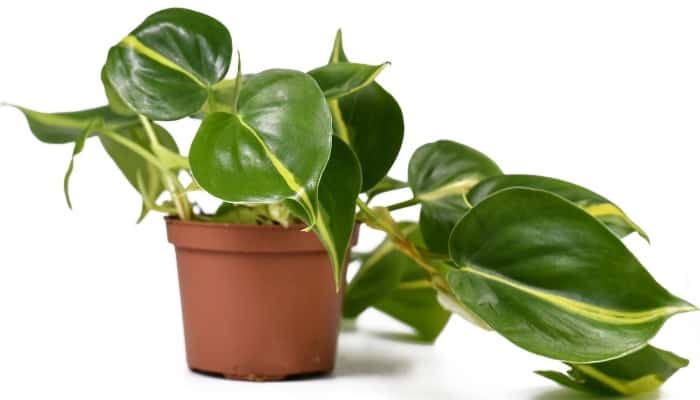
Are Philodendron Brasil Slow Growing?
In the warm season, Philodendron ‘Brasil’ grows rapidly.
For an indoor plant, this type of growth could be all year round as temperatures indoors are ambient and provide the optimum growing environment.
Philodendrons grow exponentially in warm temperatures, high humidity, and bright indirect light.
Why Is My Philodendron Brasil Not Growing?
Several reasons could be causing your philodendron to die. First, check that the plant is not being overwatered as waterlogged soil can cause root rot – it prefers moist but not soggy soil.
Also, underwatering can cause the leaves to droop and turn brown. Finally, avoid temperatures below 50°F (10°C) as these plants cannot endure low temperatures.
Can Philodendron Brasil Be Planted Outside?
Growing this plant outdoors would depend on the type of climate you live in as the philodendron is a tropical plant that is not frost resistant and prefers warmer temperatures that do not go below 50ºF (10ºC) at night.
Can Brazilian Philodendron Go Outside in the Summer?
Placing a Brazilian philodendron outdoors when temperatures are warmer in the summer can promote growth.
Remember to keep an eye on the temperature gauge so you can bring the plant indoors should the temperature start to drop.
Can Philodendron Brasil Climb?
This philodendron is a great climber. It loves to trail or climb and its vines can grow from 10 to 20 feet long (304 cm – 609 cm).
You can easily train them to grow upwards using a a trellis or support of some kind.
Why Is My Philodendron Brasil Turning Pink?
Newly growing leaves can be a peachy or pink color, which turn green gradually as they mature.
Though this coloration could be a sign of disease, deficiency, or subpar care when seen on older leaves, the pink color is usually only found on new growth and is no cause for worry.
Does Philodendron Brasil Like To Be Root Bound?
This plant does not like to be root bound. While it may force the plant to bloom, this is simply a survival tactic to try and save its species.
Being root bound causes tremendous plant stress, dehydration, nutrient deficiency, and stunted growth.
Should I Mist My Philodendron Brasil?
Misting is not a requirement, but because the philodendron is a tropical plant, it enjoys growing in moist, humid conditions, which misting promotes.
For increased growth and plant happiness, a little misting goes a long way.
Why Is My Philodendron Brasil Turning Yellow?
Several reasons can cause yellowing leaves. Ensure the plant is in bright indirect light as direct sunlight or insufficient light can cause yellowing leaves.
Overwatering can cause root rot, and underwatering can also cause leaves to yellow and die. Water twice weekly, allowing the top 2 inches of soil to dry between waterings.
How Do You Keep a Philodendron Brasil Bushy?
To create a bushier appearance you will need to prune your Brazilian philodendron regularly.
Always pinch the leaf off just above the leaf node; this will prevent the plant from producing long trailing vines and bulk up the leaf growth.
Can Philodendron Brasil Revert?
The plant can revert to an all-green leaf without variegation if it is not getting enough bright indirect light. This change could also be a weak genetic mutation.
Consider trimming the leaves back to where the variegated leaves begin to encourage the node to produce variegated leaves.
Don’t be tempted to remove all the green leaves, as the plant needs a balance of both green and variegated to generate enough energy to grow.
Can Philodendron Brasil Grow in Water?
The philodendron can be easily propagated and left to grow in water on a permanent basis. Propagate the plant in a clean jar of water, changing the water every three days.
Once it has rooted, place it in a bright location avoiding direct light. You can learn more about hydroponic growing here.
Why Are My Philodendron Brasil Leaves So Small?
If the plant does not receive enough light, heat, or humidity, it can cause the production of small leaves.
Ensuring your plant has the right environment, is fertilized once monthly, and is repotted when rootbound will encourage larger, healthier leaves.
How Do You Make Philodendron Brasil Leaves Bigger?
Providing your philodendron with the ideal environment will make its leaves grow big and strong.
Mist the plant often, give it a lot of indirect light, and ensure that you feed it on a schedule. Soon you will notice the leaves increasing in size.
5 Tips for Success With Brazilian Philodendron
1. Avoid Direct Light
This plant loves bright light but needs to avoid direct sunlight as its leaves burn easily. Instead, use a sheer curtain to filter the light if direct light is unavoidable.
2. Feeding
Fertilize regularly, using a liquid fertilizer every six to eight weeks. Be careful not to over fertilize.
3. Watering
The soil needs to be kept moist without allowing it to become waterlogged. Therefore, water your Brazilian philodendron when the top half of the soil is dry.
4. Repotting
Repotting your philodendron every two to three years will prevent it from becoming rootbound.
Although this will depend on how fast your plant is growing, repotting may be needed sooner for faster growing plants.
5. Pruning
Regular trimming will encourage thicker foliage and prevent your plant from looking thin and stringy. Use the trimmings to propagate philodendron babies.
